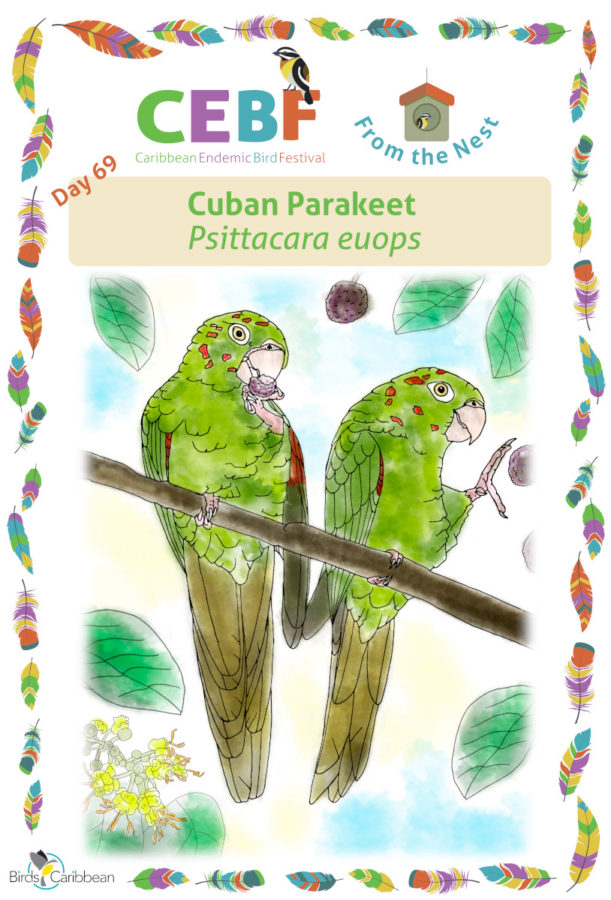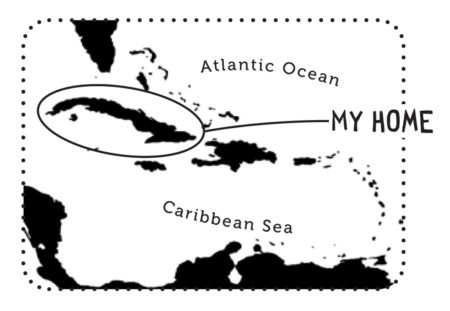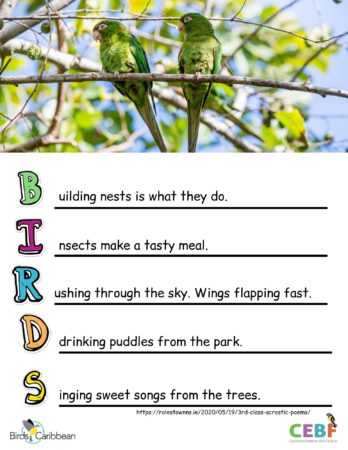Celebrate the Caribbean Endemic Bird Festival (CEBF) with us! Our theme in 2021 is “Sing, Fly, Soar—Like a Bird!” Have fun learning about a new endemic bird every day. We have colouring pages, puzzles, activities, and more. Download for free and enjoy nature with your family at home.
Endemic Bird of the Day: Cuban Parakeet
The Cuban Parakeet (Psittacara euops) is charismatic and easy to identify. It is quite a gorgeous bird—bright green with red feathers like spots scattered on the head, sides of the neck and chest. It has a white eye-ring, a long pointed tail, and a brilliant red patch under its wing can be seen when the bird is in flight. Males and females look alike but juvenile Cuban Parakeets lack the red spots on the body. It is 24–27 cm long.
This Parakeet’s beak is robust and downcurved – a useful tool for eating seeds, pods, green and ripe fruits, leaves, shoots, flowers and buds, pollen, and nectar. In fact, it feeds on over 50 species of plants.
Sadly, this striking bird is now listed as “Vulnerable.” Its numbers are declining, primarily because it is frequently caught for the caged bird trade. Farmers also still shoot them as agricultural pests. Its habitat is also threatened by extreme weather due to climate change. It was once common throughout Cuba, but now only fragmented populations exist in the Zapata Peninsula, Sierra de Najasa, and Guantánamo.
The Cuban Parakeet dwells in palm savannas; on forest edges; on tree stumps near swamps; and in some degraded forest areas, as well as undisturbed forests.
This lively parrot can express itself well. When flying, you may hear a loud, repeated crick-crick-crick. A high pitched kkkkeeeeerrrrrrrrrrrrrr can often be heard when a flock is feeding in the canopy and looking out for predators. The warning calls, increasing if there is a nearby threat, are repetitive metallic sounds of erh, erh, erh, erh. When socializing, it emits a keirp-keirp-keirp. You may hear an interesting buzzing sound made with its tail and wing feathers during rapid take off or landing.
Living in flocks of six to 50 parakeets, pairs usually mate for life. Nesting parakeets compete aggressively for the best sites: woodpecker holes in dry palm trunks, and occasionally cavities in cliffs and caves. Females lay two to five eggs between March and August.
Trapping for the pet trade remains a serious issue. Cuban Parakeets are beloved household pets. But let us remember that these are wild birds. Let’s allow them to fly free and thrive in the beautiful savannas and forests of Cuba! Learn more about this species, including its range, photos, and calls here.
Colour in the Cuban Parakeet
Download our West Indies Endemic Bird colouring page. Use the photos below as your guide, or you can look up pictures of the bird online or in a bird field guide if you have one. Share your coloured-in page with us by posting it online and tagging us @BirdsCaribbean #CEBFfromthenest
Listen to the calls of the Cuban Parakeet
The Cuban Parakeet has many different calls to communicate with members of its flock. A shrill and squeaky call is often heard when this bird is in flight.
Puzzle of the Day
Click on the image below to do the puzzle. You can make the puzzle as easy or as hard as you like – for example, 6, 8, or 12 pieces for young children, all the way up to 1,024 pieces for those that are up for a challenge!
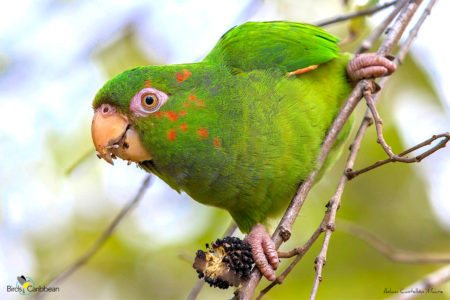
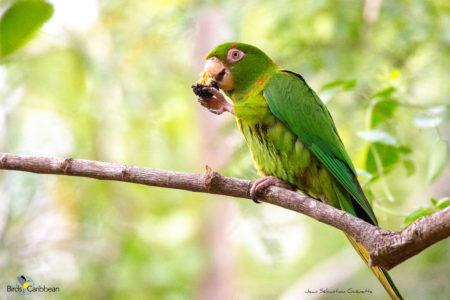
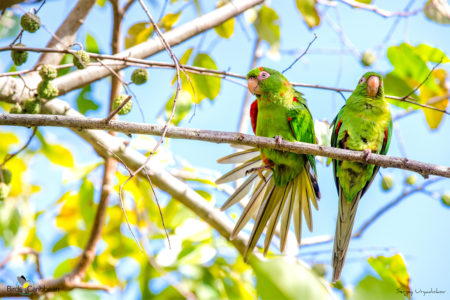
Activity of the Day
FOR KIDS: Use our template to write a poem about Parakeets! Each line of your poem should start with the letters of this birds name. This type of poem is called an ‘acrostic’. You can use words and ideas from the description and information about Cuban Parakeets above. Think about how this bird looks, its colours, the way it flies, how it behaves, where is lives and what it likes to eat. If you feel inspired you could write some more bird-themed poems! Just choose your favourite endemic bird, write it’s name vertically to get started. You can look at the birds we’ve featured so far for inspiration here.
FOR KIDS AND ADULTS: Enjoy these videos of Cuban Parakeets in the wild! The first video shows a small group of Cuban Parakeets foraging, as they flit around in the bush you can see the bright red patches under their wings. The second shows some Parakeets preening and in the final video you can see some a bird feeding on West Indian elm (guásima).

